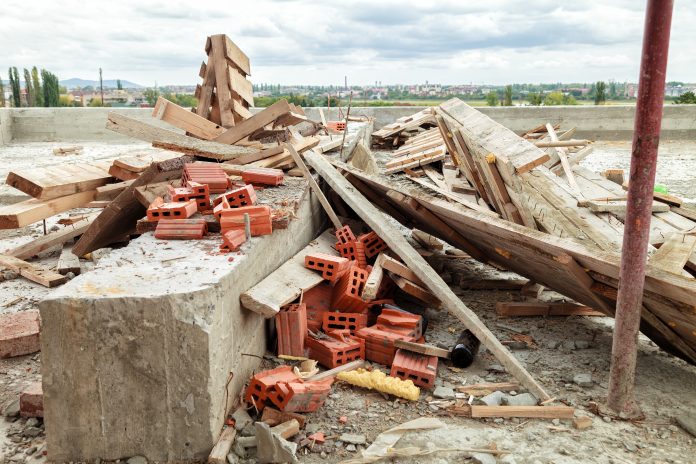Phil Sutton, founder of Econpro, discusses the waste generated by the construction industry. Construction waste accounts for approximately a third of all waste generated in the EU, including materials such as concrete, plastic, metals, and glass
The sector is the largest consumer of materials in the UK and produced an estimated 60 million tonnes of construction and demolition waste (CDW) in 2016. The volume of CDW generated, combined with separation and recovery technology that is well-developed, inexpensive, and accessible, means there is huge scope for the recycling of these materials.
Currently, an impressive 90% of CDW is recovered in the UK with heavy materials such as concrete, brick and asphalt making up the majority. These are most commonly downcycled to produce aggregates for use in roads. However, almost 5 million tonnes of waste is sent to landfill, the UK’s second most used waste treatment taking nearly a quarter of all our waste in 2016.
The plastic problem
Plastic makes up a sizeable portion of this as its use in construction is responsible for 23% of the UK’s total consumption, with 40% sent to landfill.
Plastic, whether designed for consumers or the industry, tends to have a bad reputation. Indeed, polymers destined for landfill are problematic because they do not break down for many years. However, the construction sector is understandably reliant on plastic due to its durable and versatile nature allowing it to be used for a variety of building applications such as pipes, seals, profiles, and insulation, as well as for packaging fragile construction materials.
But our view is that this dependency does not need to pose an environmental concern or hinder the achievement of the UK government’s 2018 Resources and Waste Strategy which aims to eliminate avoidable waste of all kinds by 2050, because the majority of plastic waste is recyclable.
The use of recycled materials in construction is increasing as it is beneficial from a number of different perspectives. The most obvious advantage of recycling is in terms of environment, as the adverse effects of plastic on our planet are well reported. Recycling avoids further use of landfill, minimises greenhouse gas emissions, and reduces energy consumption.
An opportunity to do more for the environment
The extraction and processing of raw materials to produce plastic requires large amounts of energy and generates CO2 emissions, but through recycling this can be reduced as fewer intensive processes are needed to turn them into usable materials. Equally, research shows that reusing CDW can save eight times as much energy and prevent carbon emissions by ten times, suggesting that there is an opportunity for the industry to do more to protect the environment.
We believe that there are many innovative methods of transforming construction waste into sustainable products. For example, road kerbs manufactured from recycled plastic provide the construction industry with an environmentally friendly alternative to traditional concrete.
We created Durakerbs and Duradrains, which are comprised of 88% recycled polymer, the equivalent of 182 plastic bottles. Any contractor using these products has helped divert thousands of tonnes of plastic from entering landfill and saved a total of 12,000,000 kgs of carbon from entering the atmosphere, which can be attributed to decreased output during production.
But the benefits of choosing to recycle go beyond addressing the urgent climate crisis. Recycled plastic is lightweight and doesn’t always require the operation of heavy machinery, which offers a reduction in the risk of workers developing medical conditions.
Exposure to carcinogenic respirable crystalline silica (RCS) is also eliminated when using plastic on site, as the material does not emit harmful airborne chemicals when cut unlike many building materials such as bricks, tiles, concrete and mortar.
The cost-effective potential of recycling
Opting to recycle saves on disposal and landfill fees as well as the purchasing of new materials. It is true that in some cases, it may be cheaper to manufacture building supplies from raw materials. However, when accounting for installation costs, the price margin is dramatically reduced compared to concrete, as plastic can be installed faster using less labour due to its lightweight nature.
Even if the overall costs of using green materials in construction is greater, recycling should still be ranked highly by companies as it offers a competitive advantage in a fierce market. While the industry recovers from the impact of Covid-19, the use of recycled materials in construction provides the major benefit of improved customer perception, which could be the winning factor in securing new business opportunities.
Recycling is incredibly important in the construction industry from both an environmental and economical standpoint. Businesses will incur an initial cost when adopting more environmentally friendly operations, such as the setting up of recycling facilities, but in the long-term recycling provides a cost-effective solution that drives a circular economy.

Phil Sutton
Founder
Econpro















Really interesting article. Where does the 1,200,000 kg carbon emission reduction figure come from? For example, is that an estimate of reduced carbon emissions throughout the UK over a year (through recycled polymer subsititute?) or is that a cumulative (to date) figure?